

The project is about a house In the town center of the city o Volos, and in particular in the streets Gamveta and T. Oikonomaki. The area has in general low buildings. In this, conduces the fact that the sites are rather small and that on T. OIkonomaki, which is a pedestrian zone, there are two schools.
The specific site, is 150 s.m. and is located opposite one of the two foresaid schools. The house is designed for a family of three members. It consists of four floors, basement and roof, and is a total of 320 s.m. the rooms that it consists of are sitting room, kitchen, dining room and W. C. on the ground floor, bedroom, guestroom and bathroom on the first floor, bedroom, bathroom and library on the second floor, office and library on the third floor and a swimming pool on the roof.
The intention of the project is the subsumption of the house on the urban scene and the careful design of the interior so that they serve the residents on the best possible way. Consequently the house concludes by starting the design from the interior, and by placing the different spaces on a vertical and horizontal system, so that they comprise a unified building.
Supervisor: Kotionis Zissis
Reference Number: 40


Based on the fact of the lack of public open spaces and on the need of amplifying the cultural tissue of Volos, an urban model is being suggested that could be permeated in the whole city connecting each cultural point to the other. This model is characterized by lining which connect factitiously the Pelion Mountain with the port, the two natural characteristics of the city that have shaped it for centuries.
The area of interference consists of four blocks, around the Analipseos, Chatziargiri, Koutarelia and Konstanta streets. Each of these blocks has a particular character; the first has high multi-dwelling houses that create a deep and dark vacant site. The second has multi-dwelling houses and one-family houses that create a vacant site in levels due to some elevated yards. The third is constituted by high multi-dwelling houses which are facing low one-family houses creating an oblong and narrow vacant site. In the fourth block stands the theater of the Old Electric Power Plant and the Dance School of the Municipality of Volos.
The interference proposal is constituted by the creation of an air route on the blocks that are under interference. At the same time, the integration of the vacant sites of the above blocks is suggested with the simultaneous creation of levels to be planted. The ramp that runs this area perforating the blocks, encounters on the left and on the right spaces that the residents of the area can gather there in order to fill their spare time productively. The route ends in the theater of the Old Electric Power Plant in the footpath of R. Fereou Street where it perforates the building in order to lead to the theater square and there becomes one with the ground.
The ramp constitutes the public part of the suggested urban model, a part that enters to spaces without disturbing their privacy since it does not come in direct contact with them. The ground of the vacant sites constitutes the private part of the proposal since it is shaped into yards for the residents of the block. The ramp during its route encounters spaces of cultural- recreational character for the residents of the area (painting – pottery workshops, exhibition center, meeting place, playground, photography workshop, projection room). The theater of the Old Electric Power Plant is at the end of the route, which is reconfigured with the ramp passing by it and ending inside the suggested building of the dance school. In the same block, the creation of a square with levels in which the history of the urban route is integrated is being suggested.
In a city that lacks public open spaces and that is characterized by fragmentation of cultural- social activities, the suggested urban model comes to enliven, to vivify the dead urban space, to create elevations of public open spaces in order to end in the sea of Volos, in the Pagasitikos Gulf. It also helps in the strengthening of the social relations among the residents of the blocks generating poles of cultural- recreational activities in the neighborhood level. It passes from the minor scale – vacant site and residents’ privacy- to the big scale – square, public park – combining them in a game of reading of the urban space, discovering it and usurpation of it from the beginning that if we look it again it can create new relationships, new dipoles, and new approaches in our cities.
Supervisors: Gavrilou Evelyn, Giannisi Phoebe
Reference Number: 15


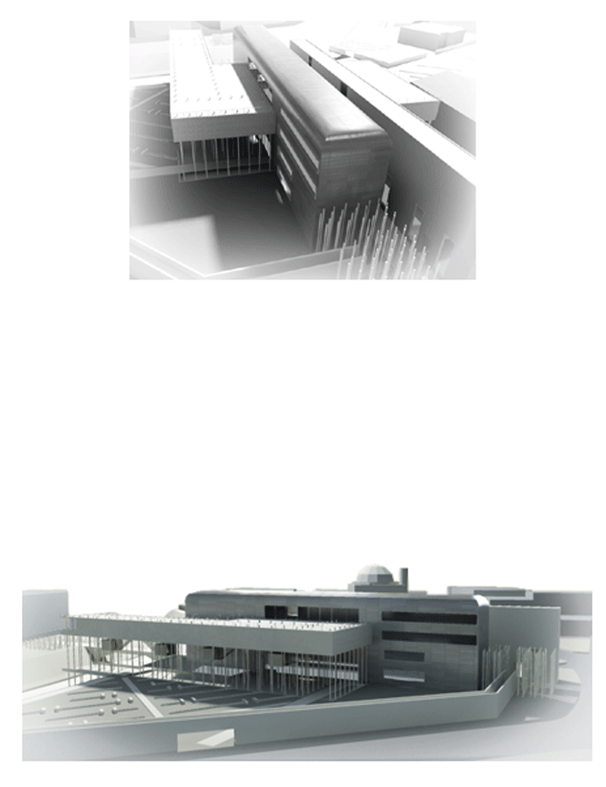

The research of the project: “Library in the town of Trikala near the river of Letheos – Knowledge and Lethe” the search was based on two starting –points:
1. the construction of a library which, being a social need, will fulfill the requirements set by the contemporary times and the town itself, and
2. the conditions under which the new activity is placed among this particular area of urban tissue and the town in general, taking the place of the prison building (which is transferred out of city) and “discussing” with the river of Letheos.
Each starting –point includes the speculation of how, on the one hand, a new –in style and framework –social activity and on the other hand a building form, may affect balance, create new circumstances and have the possibility to put into shape the public space that it’ s placed into (semi –urban zone situated by the river).
The choice of the place by the river (in the Saint Constantine’s park where there are located the scheduled building of the mosque, the prison of the town, the church of Saint Constantine and a school) and in proximity from the center of the town, reveals first of all the spirit for the creation of a new pole in the urban tissue, on town planning level and to restore the park, which looses its dynamic because of the prison’s existence.
The concept that led to this designing is based on a personal explanation of the dipolar Knowledge –Lethe, as well as to the rendering of the library as a useful public element. Actually, a library, beyond the freedom that it offers by the process of knowledge, it maybe lends by itself to coercion. This relationship between freedom and coercion was tried to be translated synthetically. Two high parallel compact volumes run across the ground. Between
them “runs” a pedestrianized street that follows the volumes and it overruns them, while at 8.00m high the two buildings are intersected by another built volume. The knowledge bores the Ignorance the Freedom is shaped as drilling of another shaped space.
The challenge to meet successfully all these parameters, as well as the desire to “open” this area of urban tissue that is “sealed” today because of the prison’s existence, dictated this proposal, on the one hand for the “outside” plan, the basic points for the lay, out of the public space but especially for the “inside” plan of the building, as a structure with prerequisite uses and also as a shape that interacts with the “outside”.
The building with its shape enters to interplay as the regulator of the new situation. The building does not exist without the environment that it has created and the environment is being formed by the building.
Supervisor: Antonas Aristide
Reference Number: 9
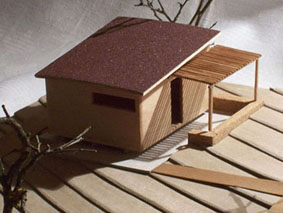

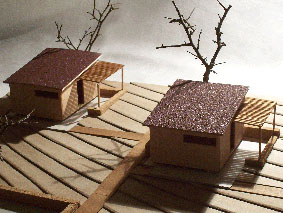

The subject of this thesis is the construction of a camping site for children located in the community of Mandraki, prefecture of Serres.
The selection of the particular subject stands on the community’s decision in collaboration with the municipality of Ampelokipi, Thessaloniki to construct a camping site. The relevant application was submitted to the municipality in 1999; an area of 20.000m2 was granted by the community of Madraki as well. The area is situated at the side of mountain Belles, north of Kerkini lake in a wooded area. The site is very close to the lake which comprises one of the most important aquatic lands in the country.
The camp can put up 260 children (130 boys, 130 girls) aged 6-12. Its facilities consist of 26 dorms, those of the camp’s chief, guard and personnel; kitchen, dinning area, arts music and theater rooms respectively, sports and fitness rooms, library, infirmary, church, restrooms and shower rooms. Furthermore, sports facilities are also available that consist of a soccer court 5x5, 2 volley and 3 basketball courts; semi-outdoor areas that include table tennis, billiards and arcade games.
As far as the construction of the facilities is concerned, the project’s fundamental principle lies in the respect towards the natural environment and the construction’s accession into it. Thus the aim of this construction is the building of ground floor facilities that will not create a violent impact to the surrounding environment and will not cause any alterations in the view of the landscape.
Therefore, a light structure is recommended which can be easily reversed without any substantial alterations in the morphology of the area. Wood and rocks are the dominant building materials as it is thought they fit amicably to the surrounding natural environment of greenery and have direct connection with the aquatic element.
Supervisor: Triantafillidis Giorgos
Reference Number: 46
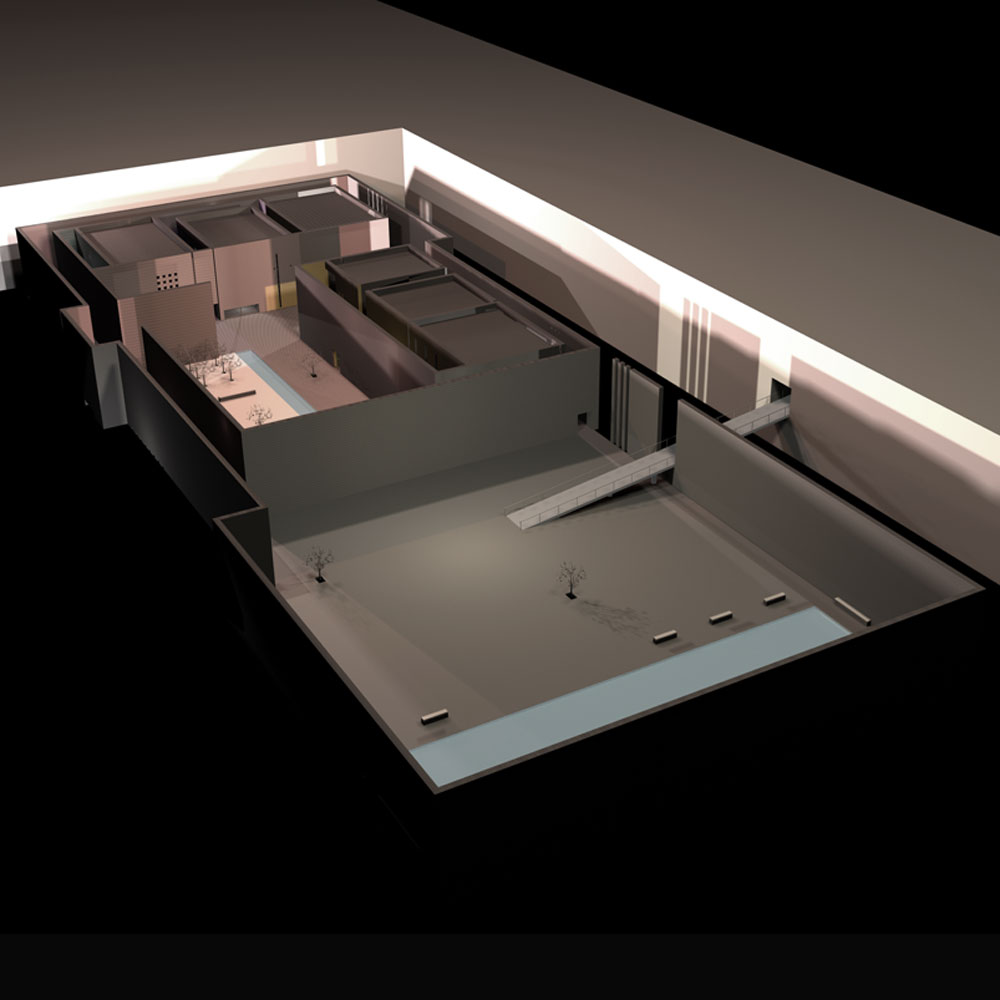

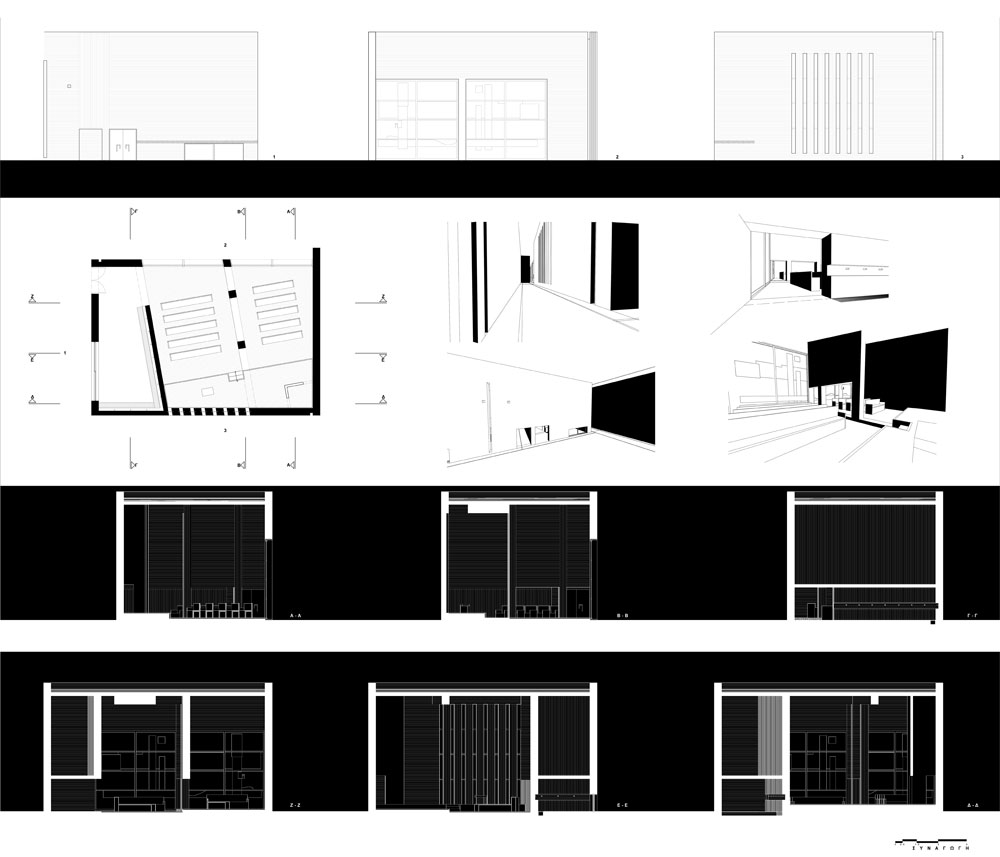

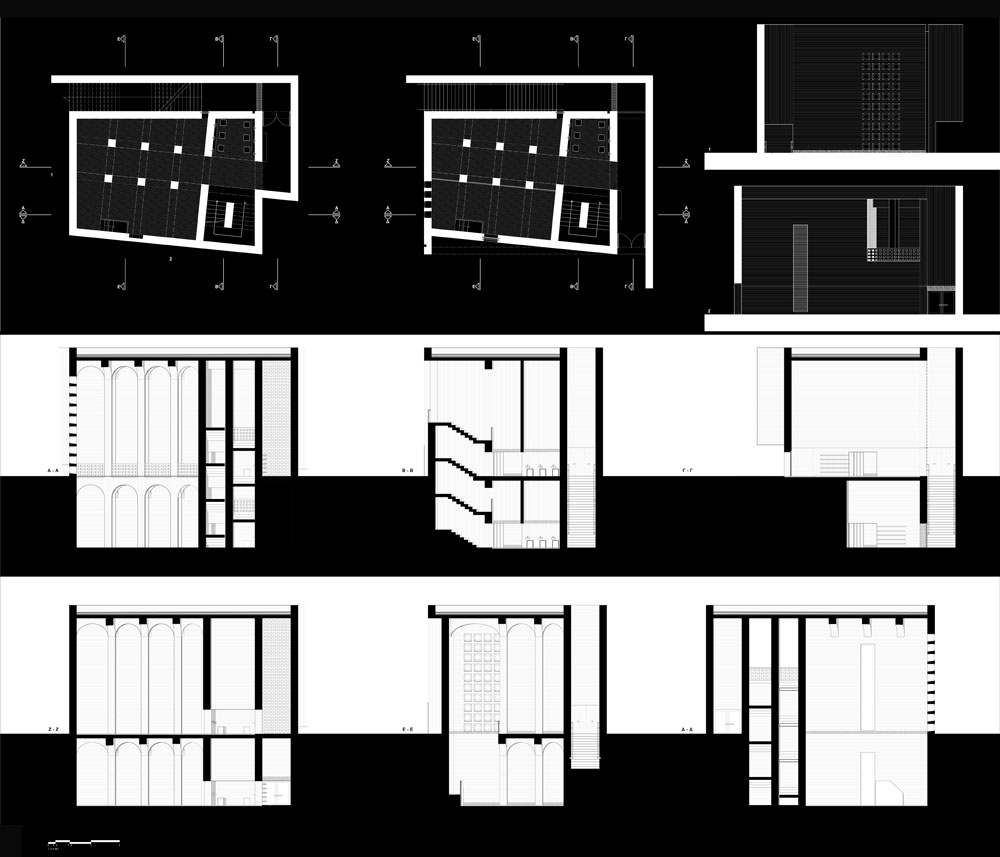

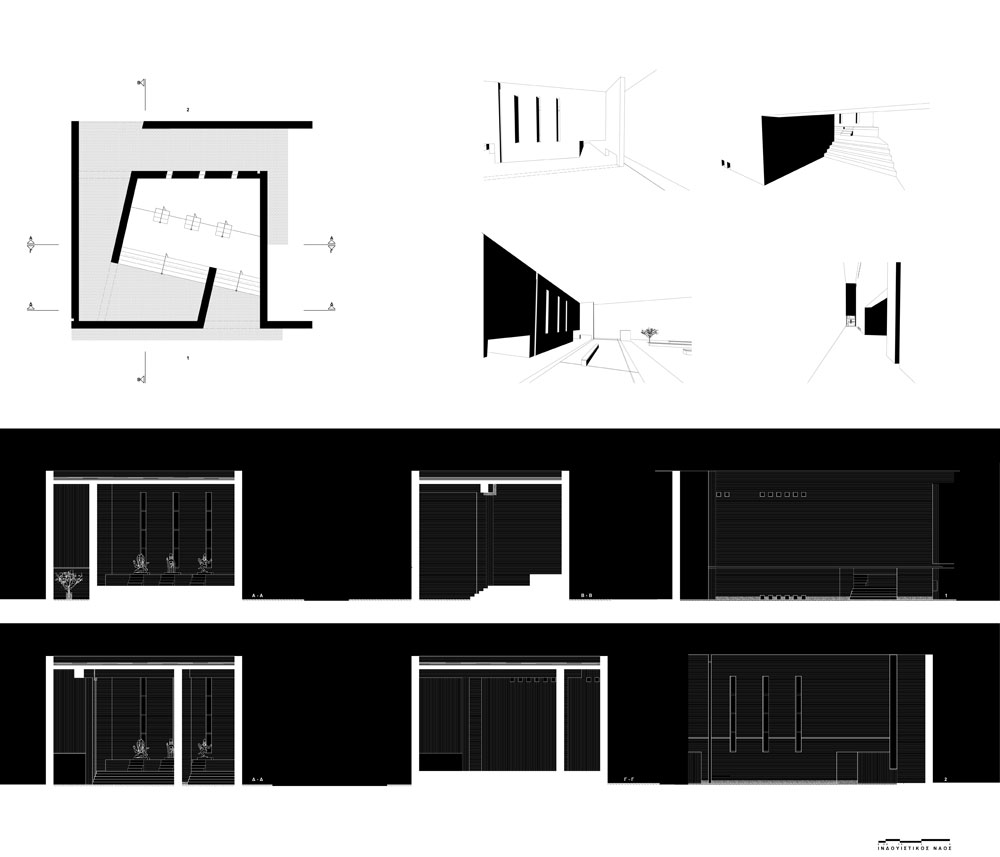

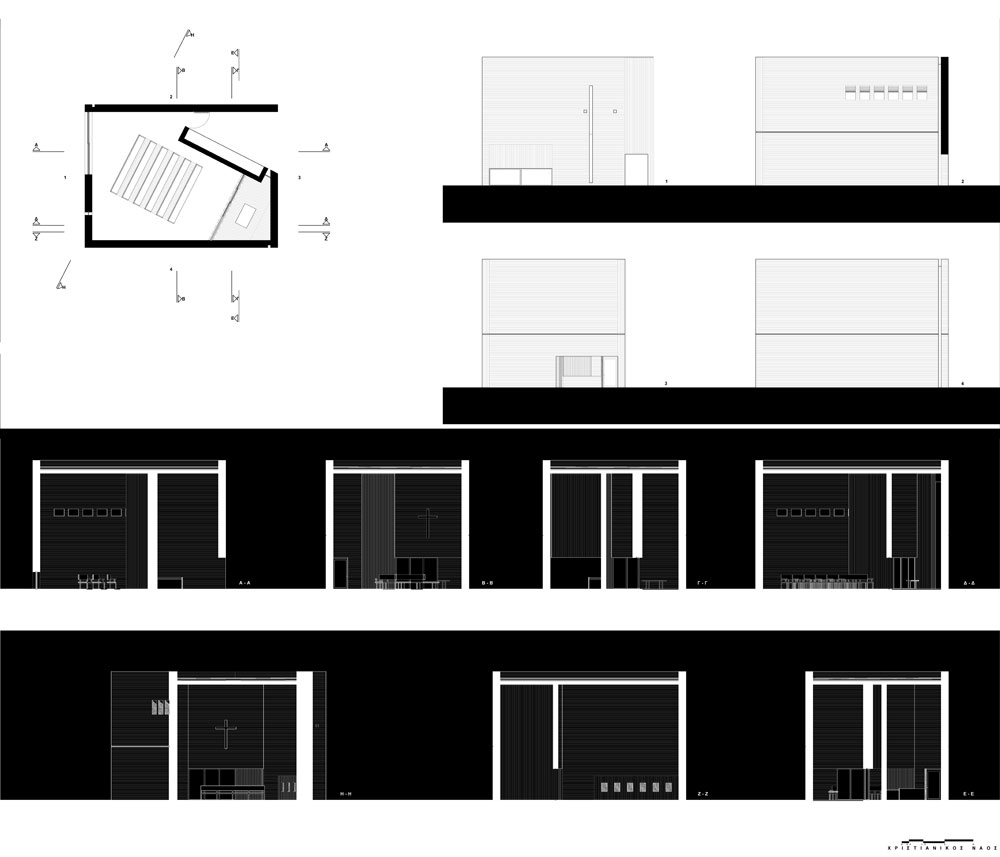

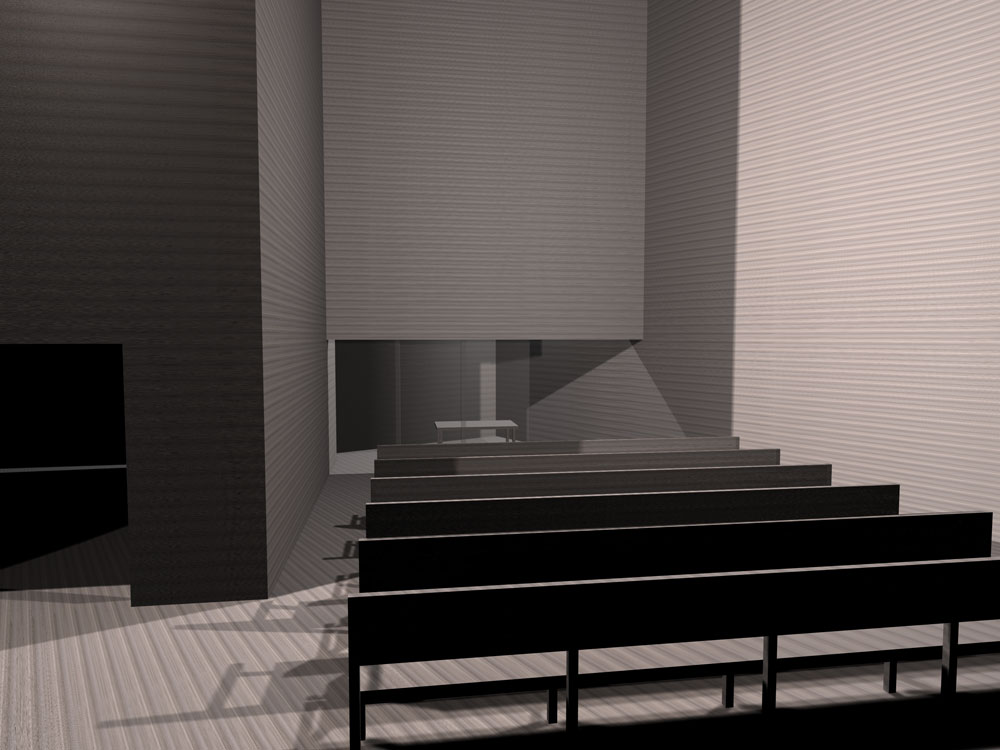

Crowds of people. Mechanistic movements. Light.
The flight.
The airport.
The “solemnity” before each flight.
Before something not normal.
The flight.
It is about the creation of multi temple in the airport Eleutherios Venizelos, in the region that is fixed by the building of tower of control and the main volume of airport (space of arrivals and departures). It contains the temples of five basic religions (Buddhism, Hinduism, Judaism, Islamism, and Christianity), the courtyard of this holy spaces and a space of entry with the form of square - courtyard.
The creation of a multitemple in the airport has as aim, beyond its operation as temple, the installation of an area capable to form an environment, which characteristics function additionally to those of the airport: the movements, the light, the people, the materials, "convert" the time and the region of this intervention. It is a space of peacefulness, of calm capable to relax the knot of abdomen before the flight - the last glance of αtraveler to reality -.
The form of multitemple is presented in the airport with the form of a closed system, a box: the "box of religions". The "different" space is closed in, leaving small cracks of view and communication. This introversion does not aim at the alienation and removal of its interior from the airport but on the contrary has as target the creation of a wish of entry in its interior and the creation of limits that will encompass the temples.
The “Box of Religions”:
The entry in the internal area of the multitemple is succeeded with a ramp which connects the airport (more concretely the space of departures that it is allowed in travelers with ticket) with the interior of the "box". Entering in it, the ramp leans and softly leaves the traveler in the first part of multitemple, which is characterized by the material absence of temples and functions as a square or a courtyard. Constitute a transition region from social to holy. A kind of space -filter that tries to releases the functional attributes of airport preparing the traveler for his course in the temples or offering his calm. The internal space of the "box" is constituted by falls back of his exterior wrapping, a wrapping that creates the courses, the ways, the void and the constructed areas. The traveler is transported more deeply, to the temples through opening ups of his falls back walls. The temples are structured in two parts of a building total that become autonomous through slots and openings. Without particular characteristics in the exterior rind that would determine the religion of each temple, they are ordered in the space taking into consideration their historical time relation. There common skin and there structure – which is characterized from the pursuit of orientation –unify notionally and practical the space of religious human, change it from a simple area with temples to a multitemple. There are presented to be the only limits, the “uses” of a courtyard, of an un-constructed free area for the religious human. The search of the right temple is being inherent in the area like a part of a holy game, started from the courtyard and end in the interior of temples.
Supervisor: Kanarelis Theoklis
Reference Number: 5


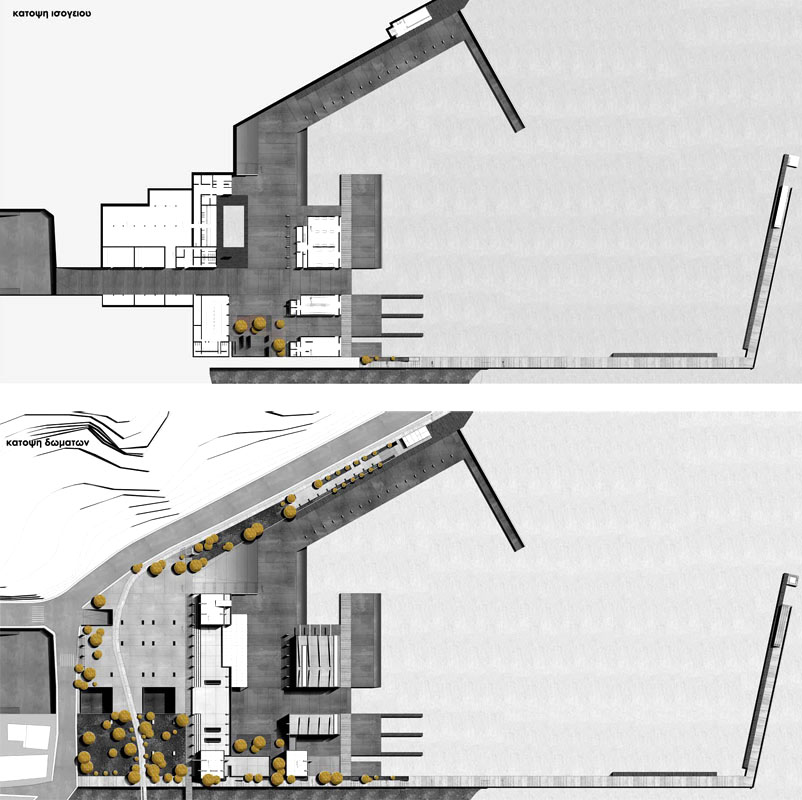

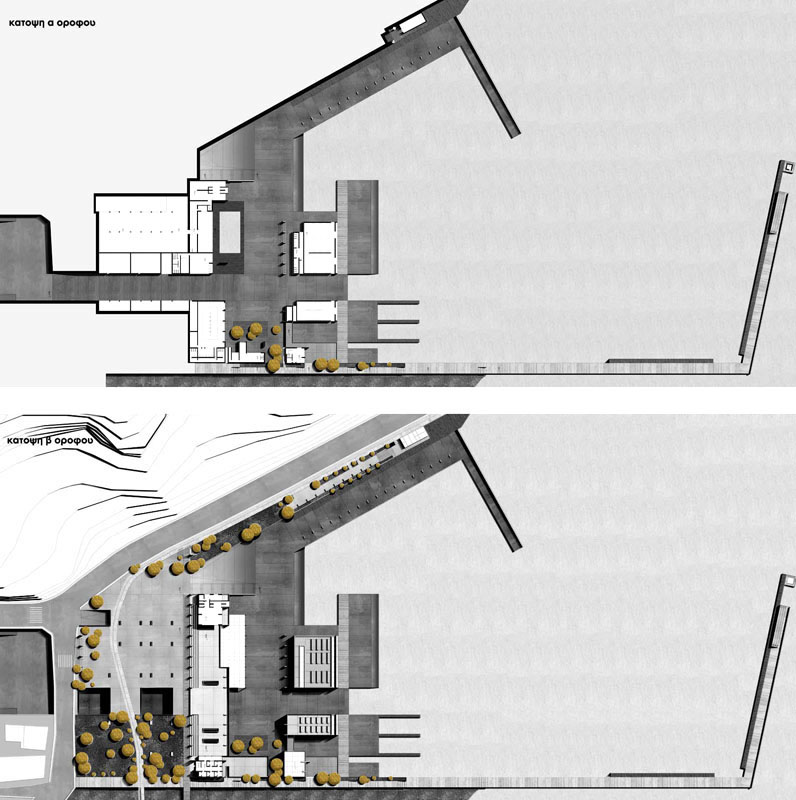

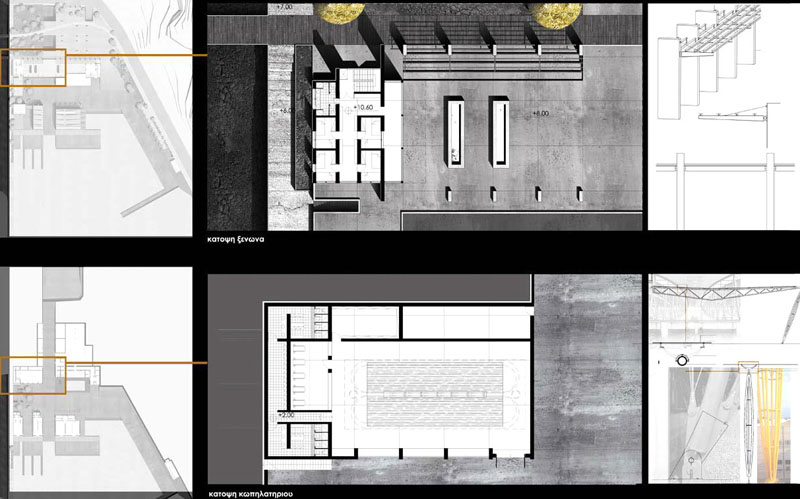

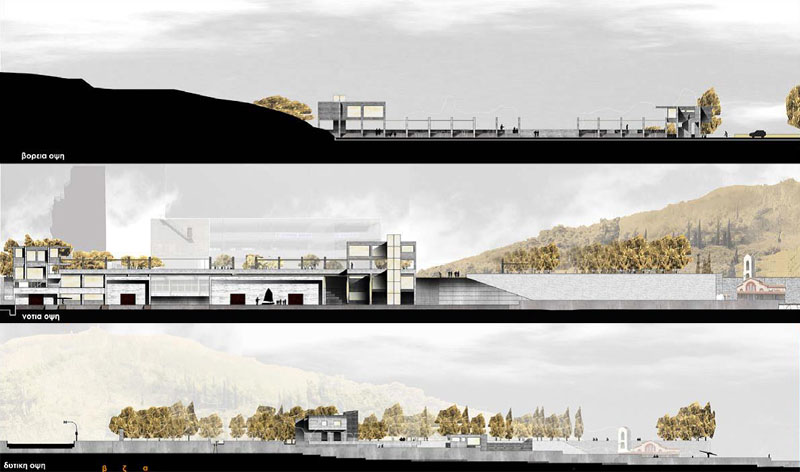

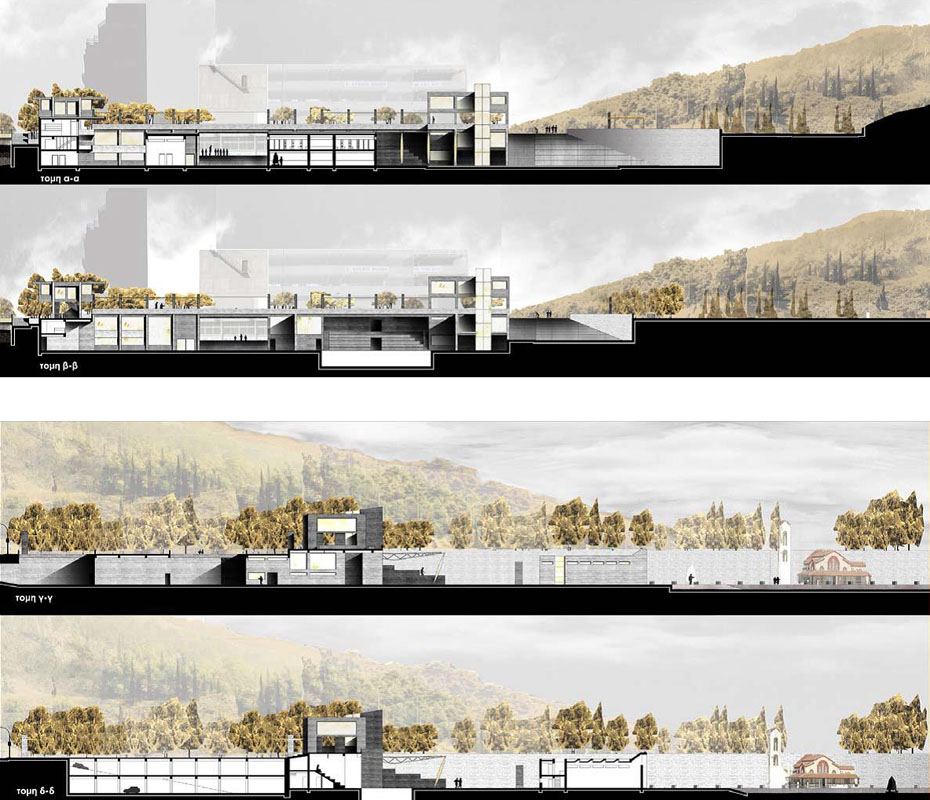

The selected area is located at Volos, at the region of Anauros. It was chosen as a reference spot, the point that identifies the exit and the entrance of the city. It is the place that concentrates movements from the road network of the rest of the city, and “conducts” them to its inner space.
The results of an urban analysis reveal that the specific area is surrounded by some strong physical elements, which constitute its boundaries and prevent either the movement or the visual contact from one place to another. Those boundaries isolate the specific area making it almost inaccessible.
This project aims to connect this area with the surrounding urban space and this will be achieved by different ways. The concentration of public, apart from private uses, the creation of a pedestrian network that penetrates the region, and the intruding of the city itself into the area, will unify it with the rest of the city.
The existing uses (rowing and sailing centre) will be maintained, but will be enriched by other athletic educational and cultural uses.
The mentioned boundaries intrude to the area and interact with it. The location and design of the structural planning of the project in relation to these boundaries empower their existence.
Three main movements are created; -each one of them identifies the connection with the surrounding area in a different way-. The first one indicates the structural elements, and consists of all the buildings and uses. The second identifies the penetration of urban space into the area, by forming a part of the new pedestrian network, and the third identifies the connection of other educational uses into the existing private space.
As far as the design of the rowing and sailing centre is concerned, it is influenced by some outer elements such as the design of the existing school, or the rhythm and movement of the body during the training.
The design is clear, follows a strict structure and a specific rhythm that sometimes is repeated to form inner and outer space.
Supervisor: Papadopoulos Spiros
Reference Number: 31
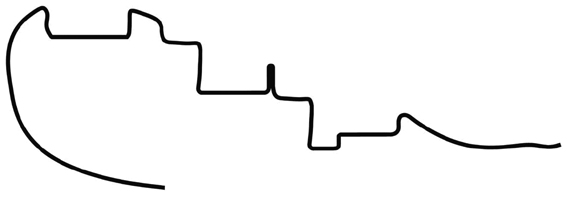

The aim of this thesis is to design interventions along the bank of Edessaios River, in order to experience the flow of water, during the day, but also throughout the city of Edessa. Firstly, the water shortage during the night is taken into account, and this problem is faced with the suggestion of seven constructions at certain junctions and branches of the river within the city. Having the human senses as the basic element, along with their association with running water, these interventions and constructions are proposed on the river bank, which are integrated into the city, and they incorporate elements of urban furniture in their design. The main idea of this thesis is to spread the water administration, which will unify and classify water in the interior of Edessa, since its contemporary relationship with the city is limited to the tourist sight of the waterfall.
Supervisor: Antonas Aristide
Reference Number: 41
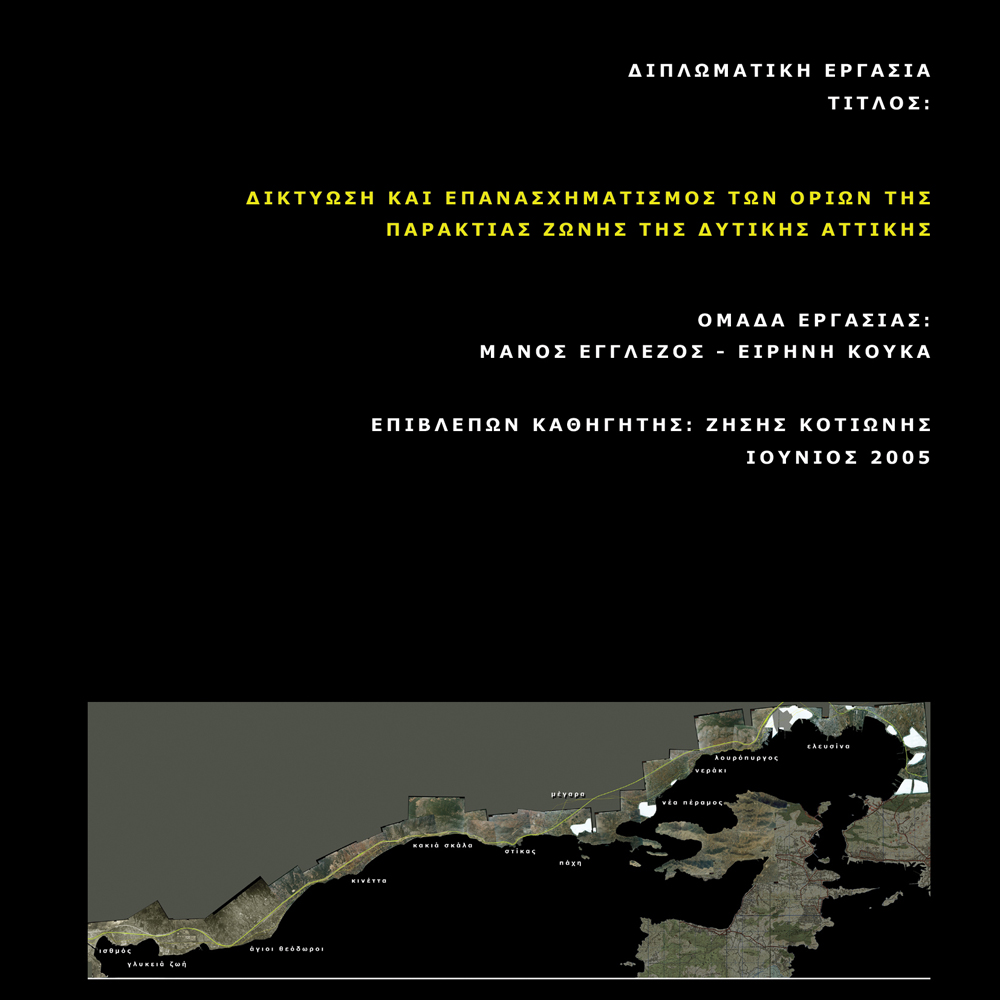

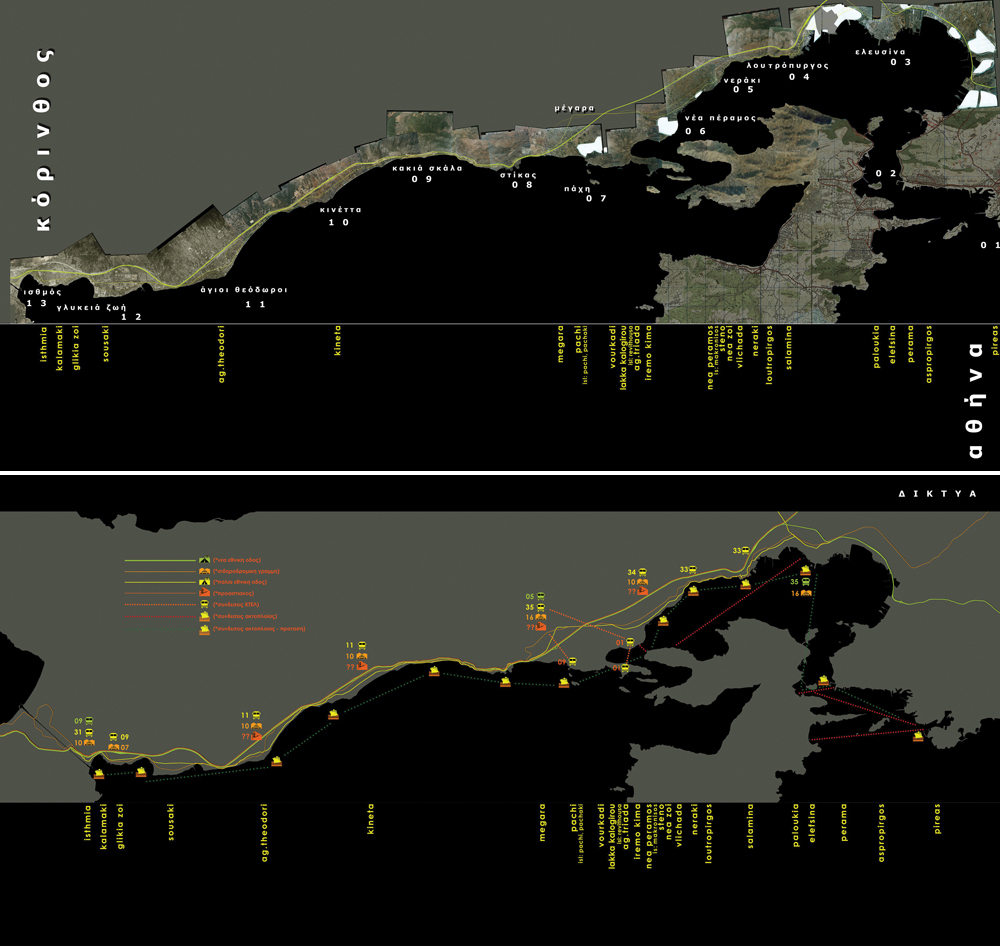

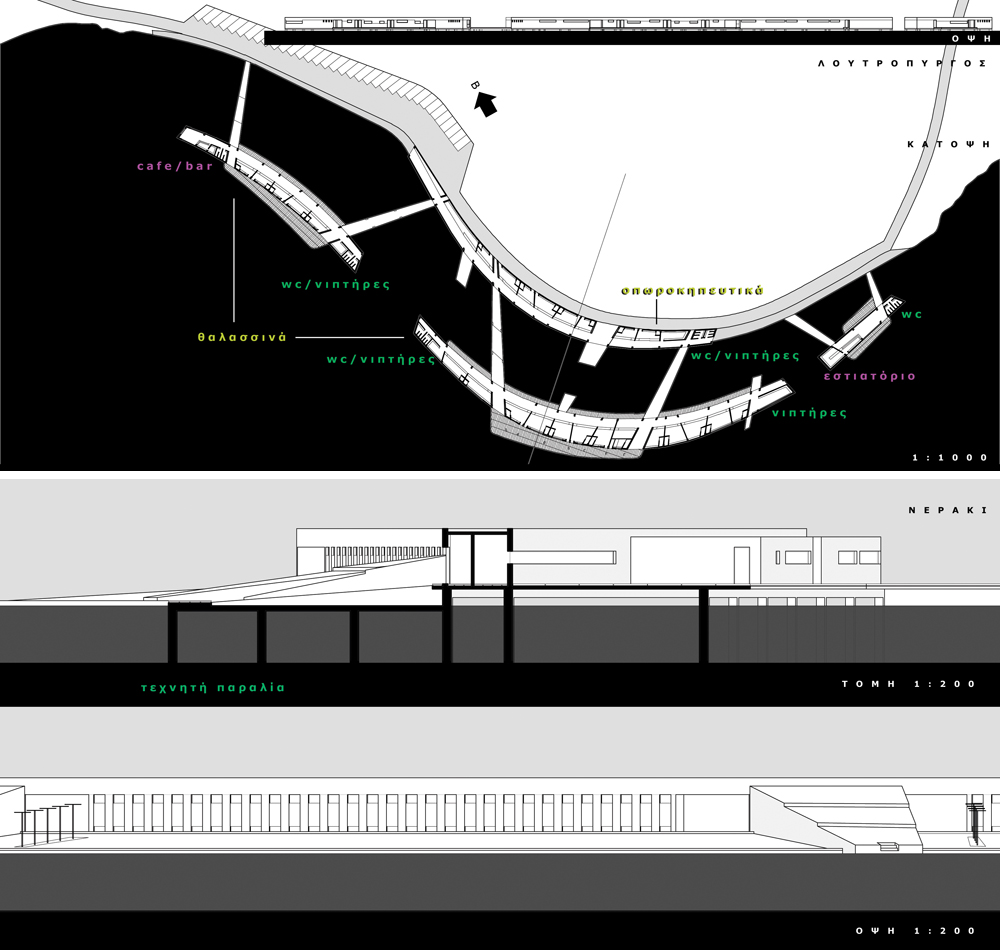

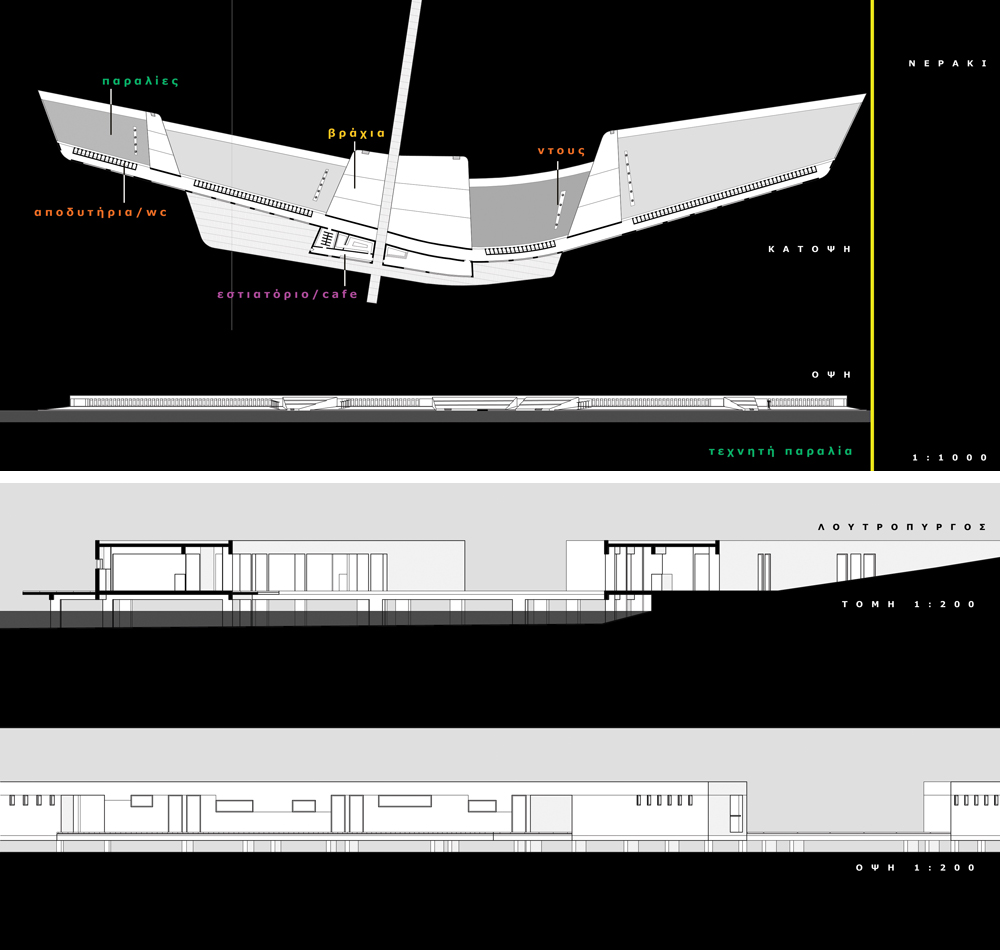

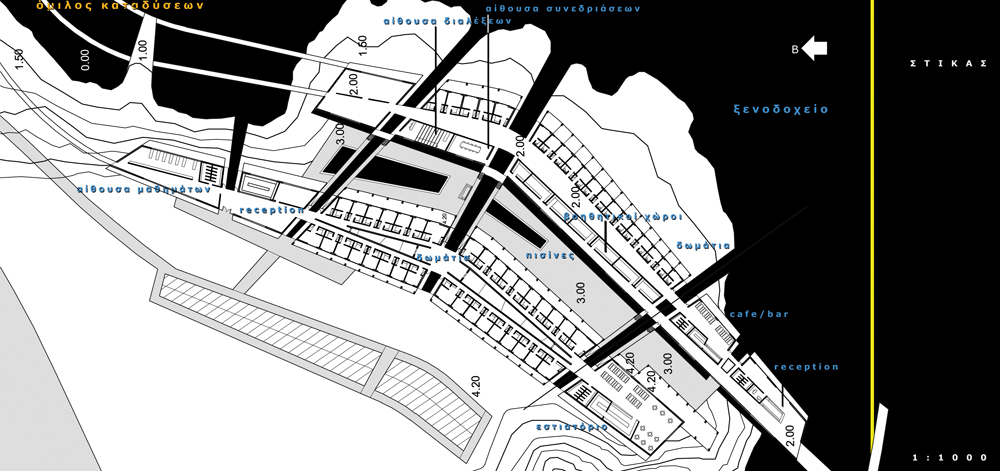

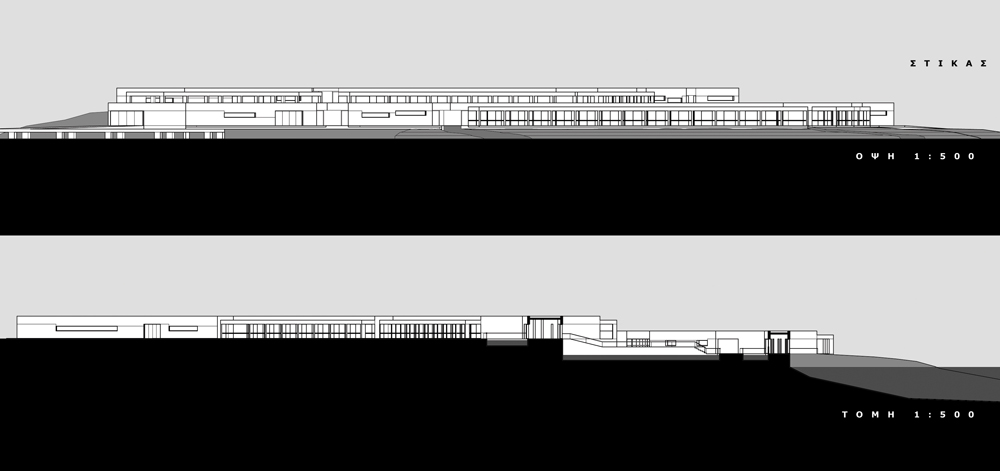

The Degree Thesis consists of a large-scale, landscape proposal that handles the natural qualities of the suburban landscape, examining the new anthropological condition regarding recreation, in relation with the contemporary social and environmental requirements of the expanding metropolis. The project elaborates Athens beyond its limits, as the city blows up due to recent infrastructures and suburban development. More specifically, it focuses on the western coastal area of the Attic peninsula (Saronikos Gulf), regarding the area from Athens to Corinth, that constitutes a lively periphery, especially during the summer season, as it attracts a lot of weekend or daylong visitors, as well as owners of vacation residences.
Among our intensions is to organize the whole area by initiating a sea - transportation network, a route with recreation and tourist stations (i.e. artificial beaches, inhabitation units /hotels, seafood restaurants /café, seafood/ vegetable markets, coastal sporting facilities, cultural facilities and more). Of great importance is the access to the stations and their connection with the other means of transportation that sweep the area (former/new national highway, intercity railway, suburban railway, intercity buses, ferry boats).
The port of Piraeus is the starting point of the root, while Isthmos/Corinth is the terminal. The coastline’s netting comprises of eleven in-between stops, some of which approach Salamina island. The stations that set the root are: Piraeus- Perama/Paloukia- Elefsina- Loutropirgos- Neraki- Nea Peramos/Faneromeni- Pachi- Stikas- Skironides Petres (Kakia Skala)- Kinetta- Ag.Theodori- Glikia Zoi- Isthmos.
Supervisor: Kotionis Zissis
Reference Number: 20

